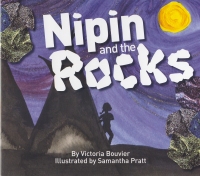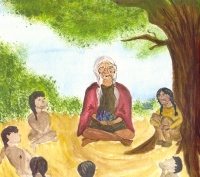| ________________
CM . . .
. Volume XVIIII Number 2. . . .September 14, 2012
excerpt:
Author Victoria Bouvier shares a wonderful tale of a young boy named Nipin who learns a valuable lesson about sharing. Each day after the midday meal, Mosom and the children gather in the shade to share stories. Mosom sits and removes treasured rocks from their hide pouch and mediates the stories of the rocks to the eager village children. One day, as Mosom shares the creation story, young Nipin becomes entranced with the brilliance of the rocks. He decides he must have the rocks to himself, and so after night falls, Nipin sneaks into Mosomís teepee and takes the rocks for himself.
The next day, Mosom emerges with the rocks, shining more brilliant than ever. Nipin is shocked at the magical restoration of the rocks. In his bedazzled state, he admits to Mosom that he stole the rocks in the first place. Mosom explains that the rocks are a gift from the universe and that they can only reveal their brilliance when they are in their rightful place in the community. Then, instead of responding in anger, Mosom takes Nipin to the centre of the circle and teaches him to listen to the rocks and share the stories of the Cree people. To enhance this delightful story, each two page spread is accompanied by lively, vibrant, watercolour illustrations. Samantha Prattís breathes life into her paintings with fluid, playful brush strokes and expressive facial expressions that capture the emotions of the characters. She also embellishes her paintings with whimsical 3-D features, including pebble rocks, crushed metallic paper, and sparkling glitter. Combined, the art work complements the story, bringing the Cree tale to life. Nipin and the Rocks shares a wonderful synergy of plot, character, and illustration while clearly emphasizing the value of culture and sharing. Recommended. Rachel Yaroshuk is a Master of Library and Information Studies student at the University of British Columbia, Vancouver, BC.
To comment
on this title or this review, send mail to cm@umanitoba.ca.
Copyright © the Manitoba Library Association. Reproduction for personal
use is permitted only if this copyright notice is maintained. Any
other reproduction is prohibited without permission.
NEXT REVIEW |
TABLE OF CONTENTS FOR THIS ISSUE
- September 14, 2012.
AUTHORS |
TITLES |
MEDIA REVIEWS |
PROFILES |
BACK ISSUES |
SEARCH |
CMARCHIVE |
HOME |

 The next day, the children all gather, waiting to hear stories, but with the rocks missing, Mosom has no stories to share. Days go by and no stories are told in the village. At first, Nipin is filled with glee at the thought of his coveted, private rock collection, but, as the days go on, the rocks begin to lose their luster. They become brittle and crack until all that is left is a pile of sand. As the rocks decay, Nipin become increasingly disappointed and is upset with the rocksí transformation. After night falls, Nipin sneaks back into Mosomís tent and returns the dusty remains of the rocks.
The next day, the children all gather, waiting to hear stories, but with the rocks missing, Mosom has no stories to share. Days go by and no stories are told in the village. At first, Nipin is filled with glee at the thought of his coveted, private rock collection, but, as the days go on, the rocks begin to lose their luster. They become brittle and crack until all that is left is a pile of sand. As the rocks decay, Nipin become increasingly disappointed and is upset with the rocksí transformation. After night falls, Nipin sneaks back into Mosomís tent and returns the dusty remains of the rocks.